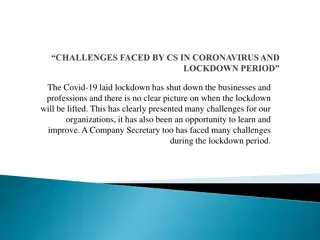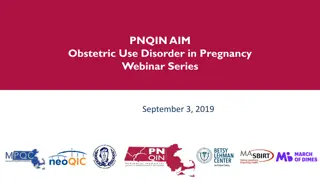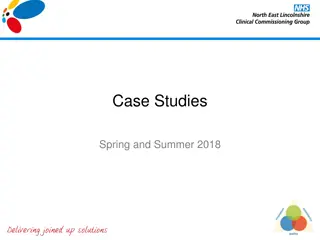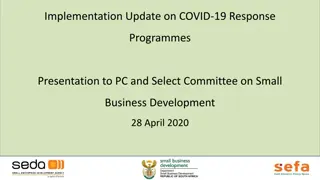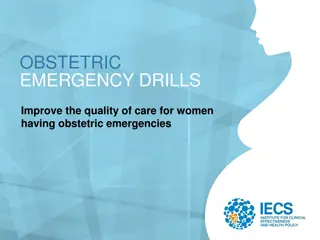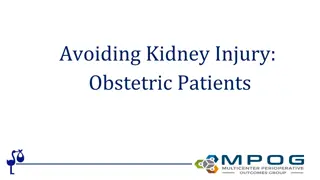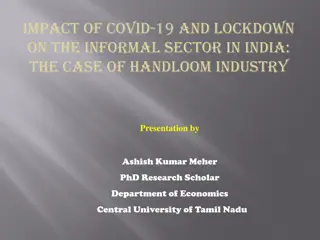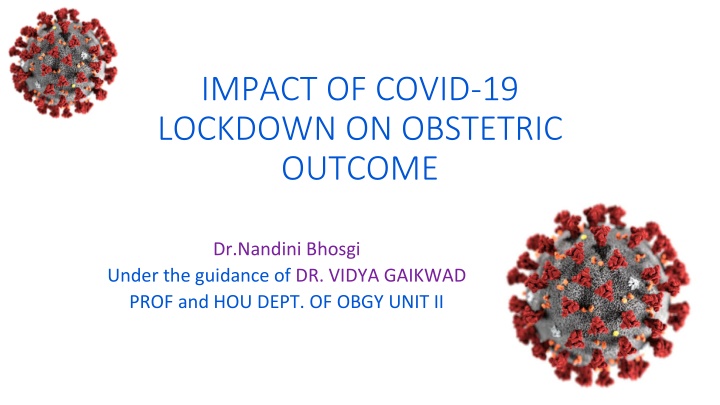
Impact of COVID-19 Lockdown on Obstetric Outcome Analysis
This study delves into the repercussions of the COVID-19 lockdown on obstetric outcomes, highlighting issues such as limited access to antenatal care, lack of nutrition, and increased risk factors for pregnant women. The data presented emphasizes the challenges faced during the pandemic and its consequences on maternal health care services.
Download Presentation

Please find below an Image/Link to download the presentation.
The content on the website is provided AS IS for your information and personal use only. It may not be sold, licensed, or shared on other websites without obtaining consent from the author. If you encounter any issues during the download, it is possible that the publisher has removed the file from their server.
You are allowed to download the files provided on this website for personal or commercial use, subject to the condition that they are used lawfully. All files are the property of their respective owners.
The content on the website is provided AS IS for your information and personal use only. It may not be sold, licensed, or shared on other websites without obtaining consent from the author.
E N D
Presentation Transcript
IMPACT OF COVID-19 LOCKDOWN ON OBSTETRIC OUTCOME Dr.Nandini Bhosgi Under the guidance of DR. VIDYA GAIKWAD PROF and HOU DEPT. OF OBGY UNIT II
IMPACT OF COVID-19 Covid -19, discovered in Wuhan, China, in December 2019, affected 195 countries worldwide, 7.5 million affected,1.3 million dead. Pandemic status declared by WHO on 11th march 2020.India reported its First Positive case of the novel coronavirus (nCov) from Kerala on 30th January 2020.GOI declared nationwide lockdown on 24th March, when number of confirmed positive cases was 500, as a preventive measure against the spread of COVID 19 Pandemic in India.
LOCKDOWN Limiting movement of the entire population as a preventive measure against the spread of COVID-19 pandemic In India lockdown was imposed by GOI from 23 March to 30 July
ANTENATAL CARE Systematic supervision of a woman during pregnancy to detect any complication / adverse event during pregnancy at the earliest Aims To screen the high risk antenatal cases To prevent / detect / treat at the earliest any complication during pregnancy To ensure continued risk assessment during pregnancy
IMPACT OF LOCKDOWN ON ANTENATAL CARE SMALL HOSPITALS CLOSED NO ACCESS TO TRANSPORT/ NO TIMELY ACCESS TO EMERGENCY OBSTETRIC CARE FEAR OF COVID 19 INFECTION DURING HOSPITAL VISIT LATE PRESENTATION OF HIGH RISK ANTENATAL CASES
LACK OF ACCESS TO RIGHT NUTRITION LOSS OF FAMILY WAGES LEAD TO INCREASE INCIDENCE OF ANEMIA & ITS RELATED COMPLICATION DURING PREGNANCY 1) Preterm delivery 2) preeclampsia and it s related complications like placental abruption 3) Fetal growth restriction & Intra uterine fetal demise REDUCTION IN HEALTH SERVICES DURING LOCKDOWN AND OVERBURDENING OF MIDWIVES AND HEALTH WORKERS WITH COVID19 DUTIES DISRUPTED THE MEDICAL SUPPLIES AFFECTING THE MATERNAL CARE
Total number of deliveries during lockdown (April-July20)in OBGY department (all 5 units) - 1567 Total number of deliveries during lockdown - 602(in unit 2) Number of High risk cases in the period of lockdown (April - July 20) - 506(in unit 2) 84% of total deliveries were high risk antenatal cases admitted for delivery during the period of lockdown
HIGH-RISK/ PREGNANCY COMPLICATIONS WHICH WE ENCOUNTERED IN OUR UNIT DURING THE PERIOD OF LOCKDOWN- APRIL TO JULY(4MONTHS) HYPERTENSIVE DISORDERS IN PREGNANCY ANEMIA IN PREGNANCY ANTE PARTUM HAEMORRHAGE INTRAUTERINE FETAL GROWTH RESTRICTION PRETERM LABOR POST PARTUM HAEMORRHAGE POST-TERM PREGNANCY INTRAUTERINE FETAL DEMISE
HYPERTENSIVE DISORDERS IN PREGNANCY TOTAL NUMBER OF DELIVERIES IN OUR UNIT DURING LOCKDOWN-602 NUMBER OF CASES OF HYPERTENSIVE DISORDERS IN PREGNANCY DURING LOCKDOWN=312 (51.8%) Gestational hypertension-162 Pre eclampsia-145 Non severe- 96 Severe(Bp >160/110mm of Hg)- 49 Eclampsia- 5
Majority of patients did not receive ANC care for consecutive 4 months, so presented late with complications Abruptio placentae -9 Impending eclampsia -4 Eclampsia -5 Eclampsia with massive intra cerebral haemorrhage -1 With most of ambulance services diverted to covid19 related activities and suspension of transportation facilities.women in labour found it increasingly difficult to access maternal health service, and ignored impending warning symptoms of eclampsia. Therefore severe preeclampsia cases increased three times during lockdown
HYPERTENSIVE DISORDERS IN PREGNANCY 2% BEFORE DURING 8% GESTATIONAL HYPERTENSION PRE-ECLAMPSIA ECLAMPSIA GESTATIONAL HYPERTENSION PRE-ECLAMPSIA ECLAMPSIA 32% 38% 66% 54%
ANEMIA NUMBER OF CASES OF ANEMIA IN LOCKDOWN = 394 Mild (Hb 10-10.9) - 204 Moderate (Hb 7-9.9)- 109 Severe(Hb <7 ) -9 Very Severe (Hb <4) -2 Anaemia is a indirect cause of maternal morbidity and mortality leading to other obstetric complications. During the period of lockdown we encountered more cases of moderate and severe anaemia.
ANEMIA 78% 43% before during
PRETERM LABOR NUMBER OF CASES OF PRETERM LABOUR DURING LOCKDOWN = 192 38% 16% before during
NUMBER OF NICU ADMISSIONS BEFORE LOCKDOWN ( DEC 19 - MARCH 20 ) = 142 NUMBER OF NICU ADMISSIONS DURING LOCKDOWN (APRIL - JULY 20 ) = 334 138 110 109 98 96 89 83 76 71 55 42 41 33 28 26 0 dec-19 jan-20 feb-20 mar-20 apr-20 may-20 jun-20 jul-20 aug-20 sep-20
POST-TERM DELIVERY NUMBER OF POST TERM DELIVERIES DURING LOCKDOWN (APRIL - JULY 20 ) = 159 before 7% during 33% 0% 10% 20% 30% 40%
NUMBER OF PROLONGED LABOUR CASES = 6 NUMBER OF OBSTRUCTED LABOUR CASES = 3 Non availability of adequate ambulance for covering maternity services led to the delay in reaching health care facility.
POST PARTUM HAEMORRHAGE TOTAL NUMBER OF PPH CASES ENCOUNTERED DURING LOCKDOWN (APRIL - JULY 20 ) = 14 Out of this 5 cases were delivered in our unit and 9 were referred from outside
POST PARTUM HAEMORRHAGE before 1.08% during 4.89% 0.00% 1.25% 2.50% 3.75% 5.00% 6.25%
INTRA UTERINE FETAL DEMISE / STILL BIRTH NUMBER OF IUFD CASES IN OBGY DEPT SINCE LOCKDOWN = 64 COVID-19 POSITIVE - 23 (35%) COVID -19 NEGATIVE - 8 (12%) COVID-19 STATUS UNKNOWN- 33 (51%)
INTRA UTERINE FETAL DEMISE 18 17 14 12 11 10 9 9 7 5 5 3 2 1 0 DEC 19 JAN 20 FEB 20 MAR 20 APR 20 MAY 20 JUN 20 JUL 20 AUG 20 SEP 20
STILL BIRTH AND COVID-19 Reports also warned that COVID-19 pandemic could exacerbate the still births issue due to restrictions on health services A 50% reduction in health care services due to pandemic could cause increase in the number of still births by 11.1%. Pregnancy itself is a hyper coagulable state,COVID 19 infection leads to vascular thrombosis which may ? Cause uterine-placental insufficiency.
CONCLUSION Patients could not avail the health care facilities due to lockdown restrictions during the 4 months from April to July 2020 Hence we encountered many high risk cases in large numbers as compared to before lockdown, like anaemia, severe pre eclampsia, eclampsia, Fetal growth restriction , Intra uterine fetal demise. Most of these complications could have been prevented / detected / treated at early stage and thus highlighting the importance of systematic supervision of pregnant women in antenatal period and preventing maternal and perinatal morbidity and mortality ~THANK YOU~



